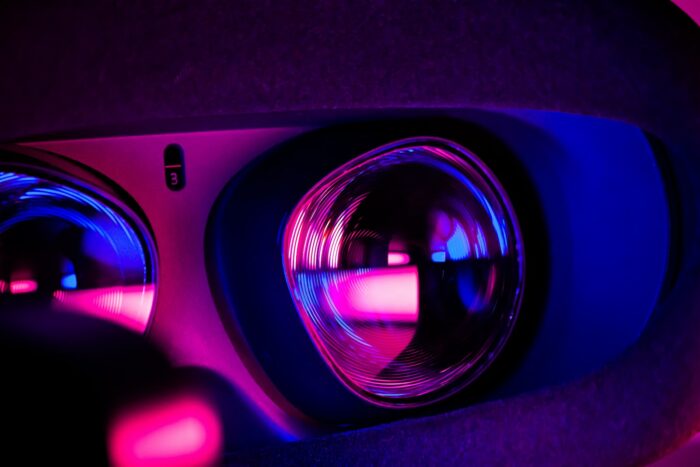Metaverse augmented reality is becoming increasingly popular, with forecasts predicting over 1.7 billion AR devices worldwide by 2024. This is because companies like Apple are making AR technology and software extremely accessible by including AR tech in all their recent smartphones.
This article provides all information about metaverse augmented reality and its future.
What is Augmented Reality?
Augmented reality enables users to superimpose virtual 3D objects onto their physical surroundings. It is an ‘enhanced’ version of the physical realm, which creates incredibly engaging experiences. It requires using a gadget such as a headset or AR glasses, and modern versions of these headsets even allow interacting with virtual elements, creating a “mixed reality.”

However, we’ll focus on metaverse augmented reality within this article and its different benefits. Imagine putting on your AR glasses and being able to look up all information about a product simply by looking at it. Or, if you’re looking to go metaverse shopping, you can even use your AR glasses to view how your clothes would look on you before purchasing them.
The glasses would overlay the clothing design onto your physical body, thus completely revolutionizing the online purchase process. People would be more confident in online purchases, leading to higher conversions.
See also: What is Metaverse? Guide into the Future of Digital Reality

What are Versions of Augmented Reality?
There are four versions of augmented reality. These versions decide how your images and data will be displayed. These are given below:
Marker Based Augmented Reality
Marker Based systems are an older version of AR, where devices capture images and utilize marker tracking and image processing to identify where to place virtual objects. The images are already filled in the database, and the system uses the position and orientation of the marked object to identify it effectively. One of the best examples of Marker-based AR is the filters introduced by Snapchat and Instagram. Users use their cameras to capture real-time images, and the markers identify where to place the filters in real time.
Markerless Augmented Reality
This augmented reality does not have any programmed objects or images for recognition. It is used in navigation applications, events, and business. It uses location-based information to identify what the user is looking at or finding in a particular region. This technology utilizes GPS, gyroscopes, and accelerometers to identify objects in real-time. The following are the types of Markerless Augmented Reality:
-
Projection-Based Augmented Reality
This version of augmented reality uses synthetic light projections. The light is projected on physical, real-world surfaces to identify the interaction of the users with physical elements. This could be particularly useful in the industrial sector, where businesses can utilize this technology to optimize industrial processes. The camera and fixed projector can help create interactive illusions to identify the depth and orientation of objects.
-
Superimposition-Based Augmented Reality
In this version, the original item is partially or completely replaced with augmentation. For example, if you take a room image, you can easily place furniture in the room using augmented reality and see how the results will be. This can facilitate users in making well-informed purchase decisions.
-
Location-Based Augmented Reality
This technology uses GPS or compass for positioning the digital item in a desired position or location. One of the best examples of location-based augmented reality is the game Pokémon Go, where users can spot different unique Pokémon in various places.
-
Contour-Based Augmented Reality
This AR version utilizes cameras to outline objects to assist in specific scenarios. For example, if users are driving in places where visibility is an issue, this AR type can assist in helping them navigate through different objects.
What are the Applications of Augmented Reality?
Augmented reality has many vital applications in the real world and has revolutionized different sectors such as Real Estate, Interior Designing, Medicine, and more.
Some of the real-time applications of AR include:
Medicine
Augmented reality has started to play a significant role in medical training. It helps the students and doctors visualize the human anatomy and allows them to scan MRIs and other imaging from different perspectives. For example, during surgery training, AR can help by displaying important information in the surgeon’s field of vision to help guide them through the process.
Interior Designing and Modeling
Visualization is essential when it comes to finalizing furniture for your home. AR can also assist in helping users visualize how their wall colors, hangings, and other elements would look virtually from the comfort of their homes.
Educational Classrooms
AR has helped transform educational classrooms into interactive learning spaces where students can learn through engaging virtual elements. This has been proven to enhance retention and increase interest in the curriculum. Imagine learning about the solar system while looking at virtual representations of planets in real-time.
Retail Market
Through mobile applications, users can utilize AR to view 3D representations of the products before they’re purchased. This can help mitigate consumer uncertainty when shopping virtually. For example, individuals can try on different clothes virtually before they make a purchase on any site.
Entertainment
AR adds an incredible layer of interactivity within the entertainment niche. Users can become active participants instead of passively watching shows. For example, users can see elements pop out of their screens. Disney recently released their first AR film where pieces popped out of television screens, and users could view interactive landscapes in their living rooms.
Tourism
This helps the traveler to examine and learn more about the locations they’re visiting. Imagine having a virtual tour guide who could tell you where to walk or the best places to explore while in a new country. You could get real-time information and can interact with virtual elements, allowing for a transformative tourism experience.

How does Augmented Reality Work?
Augmented reality overlays virtual objects onto real-world surroundings, thus creating an interactive world where the physical and digital worlds can interact. There are several underlying technologies that AR is dependent upon. These include:
Cameras and Sensors
Augmented reality depends on sensors for the algorithm to comprehend its surroundings. AR applications can determine your precise location and orientation of viewing by combining cameras, GPS, accelerometers, and gyroscopes. This then allows them to add virtual elements to the actual environment.
Algorithms
The physical environment is mapped using machine learning and image processing algorithms, which also decide where to place the virtual objects. These algorithms are essential as they help the technology determine where to place virtual objects.
Output Devices
These are the devices that allow users to see virtual objects. The most popular output device that uses augmented reality is the head-mounted display (HMD), although many individuals are currently experiencing AR through their phones.
How will Augmented Reality Impact the Marketing in Metaverse?
AR opens up numerous ways for businesses to begin marketing in the virtual realm. The metaverse is projected to be the future of social media, which makes it the perfect place for businesses to connect with their customers.
Since each metaverse has established its virtual economy using cryptocurrencies, businesses can now monetize virtual and real-life products by setting up virtual stores. For example, customers could walk into a virtual store to try out outfits using AR to see what would look best on them. This interactive experience for advertising can attract customers and can facilitate increasing conversions.
Other examples of current AR marketing in the virtual realm include Amazon’s ModiFace Virtual Makeover, which enables potential consumers to test out different cosmetics and haircuts on their faces. IKEA has also created “IKEA Kreativ,” which lets clients visualize furniture in their homes to see what best matches their requirements.
Will AR Metaverse Inherit the World?
With recent exciting developments within this space, AR is fully capable of taking the world by storm to revolutionize how we interact. Just imagine a world; where you can put on a pair of contact lenses (similar to the ones developed by MojoLens) and begin viewing real-time information on different items.
This brings about a concept of enhanced living where users can utilize this technology to create more immersive learning experiences, have more vibrant interactions, and much more.
Augmented Metaverse Reality Technology
As explained above, AR utilizes various sensors and algorithms to overlay virtual elements onto the physical world. This technology is becoming increasingly available, with most individuals using their phones to experience AR.
Users can also utilize headsets, although premium headsets such as the Microsoft HoloLens 2 can cost around $3,500. There are slightly more affordable options, such as the Google Glass Enterprise Edition 2, which costs $999. These companies are working to bring more affordable options for users; however, individuals can now experience AR through their phones.

Future of Metaverse Augmented Reality
The market is expected to reach $97.76 billion by 2028. With the metaverse set to revolutionize how users interact, work, shop, and play, AR will play a significant role in bringing the virtual and physical worlds together. This creates incredible opportunities for businesses to utilize AR for marketing.
Conclusion
We hope this article has helped explain metaverse augmented reality and its different real-life applications. AR will play a massive role in shaping the future of the metaverse, and with exciting developments such as contact lenses, users can start incorporating them into their day-to-day lives. To learn more about how AR works, click here.
FAQs
-
How does Metaverse Augmented Reality work?
Metaverse AR works by overlaying virtual objects into the physical world by using various cameras, sensors, and image processing algorithms. This technology is also present in most modern phones; however, users can utilize headsets and glasses to experience AR.
-
What are the applications of Metaverse Augmented Reality?
AR plays a pivotal role in bringing the virtual and physical realms together to create an immersive experience. AR tech can be used in training, real estate, retail, tourism, and more.
-
What is the difference between Metaverse Augmented Reality and Mixed Reality?
While AR and MR perform the same primary function, i.e., superimposing 3D virtual objects onto the physical realm, MR takes it a step further and allows users to interact with these objects in real-time. Check out much more about the topic in our article “Differences Between AR, VR And MR?”
Sources:
The Metaverse Future in 2030 Here’s what to expect. (plugxr.com)
What is Augmented Reality, and Why is it Important for the metaverse? – (blockchain-council.org)
10 Best Metaverse Platforms to Watch Out for in 2022 – (blockchain-council.org)
No VR, No Problem: How to Enter the Metaverse Without a Headset (pcmag.com)
The future of the metaverse and Extended Reality – KPMG Global (home.
The metaverse in 2040 | Pew Research Center
A Few Ways How The Metaverse Will Change Your Life (forbes.com)
AR vs. VR: Only one metaverse will inherit the Earth – Big Think
How the Metaverse Will Impact Digital Marketing (ifamemedia.com)
How AR is bringing marketers into the metaverse (contentgrip.com)
AR and Metaverse Combined Offer Significant Marketing Opportunities (cmswire.com)
How Does Augmented Reality Work? (hbr.org)
What is augmented reality, and how does AR work? (resco.net)
What Is Augmented Reality (AR) and How Does It Work? (smartteksas.com)
Top 5 Applications of Augmented Reality (AR) – Blog | Liainfraservices
Top 7 Modern-Day Applications of Augmented Reality (AR) – GeeksforGeeks
What Is Augmented Reality – Technology, Examples & History (softwaretestinghelp.com)
The State of The Metaverse Report 2022 – Nextrope
What Is the Metaverse 2022 — How to Access the Metaverse (rd.com)
For more market insights, check out our latest Digital Twin news here.













